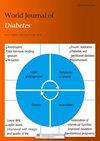采用特殊目标的糖尿病管理和治疗效果分析
IF 4.2
3区 医学
Q1 ENDOCRINOLOGY & METABOLISM
引用次数: 0
摘要
糖尿病(DM)是一种以高血糖为主要特征的慢性代谢性疾病。导致糖尿病病理生理学的最常见原因是胰岛素分泌不足、对胰岛素的组织作用产生抵抗或两者兼而有之。过去 30 年间,全球糖尿病发病率从 4% 上升到 6.4%。如果找不到更好的治疗或治愈方法,未来几年这一数字可能会攀升至 4.3 亿。导致病情恶化的主要因素包括年龄、肥胖和久坐不动的生活方式。在不影响患者依从性的前提下,寻找安全有效地控制糖尿病的新疗法一直是至关重要的。目前可用于控制糖尿病的药物包括胰高血糖素样肽-1 受体激动剂、噻唑烷二酮类、磺酰脲酶、格列奈类、双胍类以及 10 多年前发现的胰岛素靶向受体。尽管进行了大量的初步研究,但一些临床观察结果表明,这一过程仍处于早期阶段。本综述侧重于有助于胰岛素调节的靶点,这些靶点可能被用作治疗糖尿病的靶点,因为它们可能比目前的传统疗法更有效、更安全。本文章由计算机程序翻译,如有差异,请以英文原文为准。
Analysis of the management and therapeutic performance of diabetes mellitus employing special target
Diabetes mellitus (DM) is a chronic metabolic condition characterized predominantly by hyperglycemia. The most common causes contributing to the pathophysiology of diabetes are insufficient insulin secretion, resistance to insulin’s tissue-acting effects, or a combination of both. Over the last 30 years, the global prevalence of diabetes increased from 4% to 6.4%. If no better treatment or cure is found, this amount might climb to 430 million in the coming years. The major factors of the disease’s deterioration include age, obesity, and a sedentary lifestyle. Finding new therapies to manage diabetes safely and effectively without jeopardizing patient compliance has always been essential. Among the medications available to manage DM on this journey are glucagon-like peptide-1 agonists, thiazolidinediones, sulphonyl urease, glinides, biguanides, and insulin-targeting receptors discovered more than 10 years ago. Despite the extensive preliminary studies, a few clinical observations suggest this process is still in its early stages. The present review focuses on targets that contribute to insulin regulation and may be employed as targets in treating diabetes since they may be more efficient and secure than current and traditional treatments.
求助全文
通过发布文献求助,成功后即可免费获取论文全文。
去求助
来源期刊

World Journal of Diabetes
ENDOCRINOLOGY & METABOLISM-
自引率
2.40%
发文量
909
期刊介绍:
The WJD is a high-quality, peer reviewed, open-access journal. The primary task of WJD is to rapidly publish high-quality original articles, reviews, editorials, and case reports in the field of diabetes. In order to promote productive academic communication, the peer review process for the WJD is transparent; to this end, all published manuscripts are accompanied by the anonymized reviewers’ comments as well as the authors’ responses. The primary aims of the WJD are to improve diagnostic, therapeutic and preventive modalities and the skills of clinicians and to guide clinical practice in diabetes. Scope: Diabetes Complications, Experimental Diabetes Mellitus, Type 1 Diabetes Mellitus, Type 2 Diabetes Mellitus, Diabetes, Gestational, Diabetic Angiopathies, Diabetic Cardiomyopathies, Diabetic Coma, Diabetic Ketoacidosis, Diabetic Nephropathies, Diabetic Neuropathies, Donohue Syndrome, Fetal Macrosomia, and Prediabetic State.
 求助内容:
求助内容: 应助结果提醒方式:
应助结果提醒方式:


